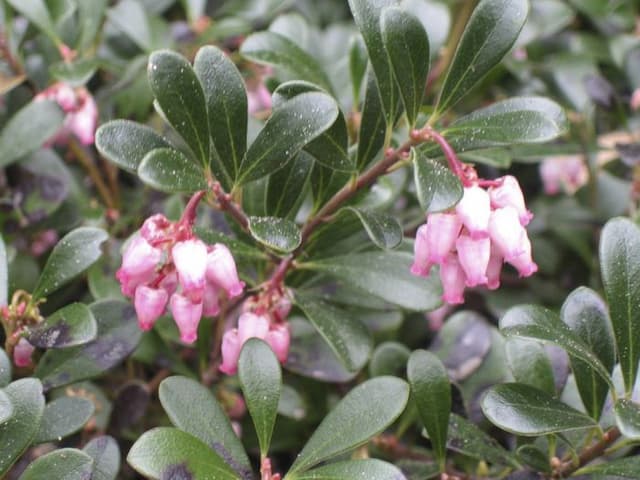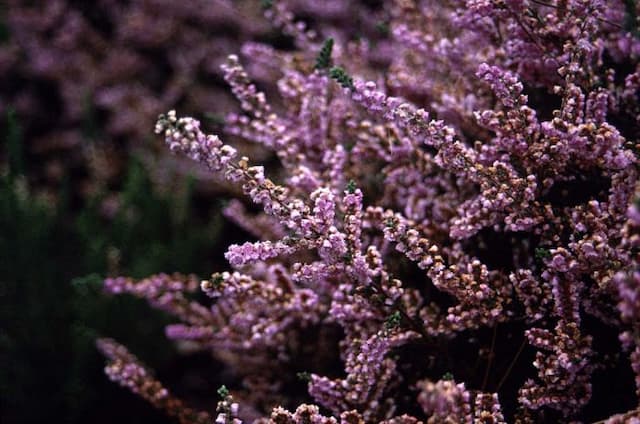Rhododendron Rhododendron 'Florida' (Ea/d)

ABOUT
Rhododendron 'Florida' is a captivating plant with a striking appearance. It is characterized by lush, evergreen foliage that provides a year-round display of glossy green leaves. These leaves typically have a smooth texture and are often ovate to elliptical in shape, creating a dense, well-structured backdrop for the plant's spectacular floral display. The flowers are the true showstoppers on this plant, emerging in clusters known as trusses. Each truss consists of several individual blossoms that can come in a range of pink hues, often with subtle variations and gradients that can give each flower a unique appearance. The blooms are typically funnel-shaped and may have a flared opening, with ruffled or wavy edges that add to their ornate look. Inside, the flowers usually have distinctive markings or stippling that can contrast with the primary flower color, making them even more eye-catching. Rhododendron 'Florida' flowers are known for their striking presence in a garden, attracting attention during their blooming period. Overall, the plant's combination of evergreen foliage and vibrant flowers makes it a popular choice for gardeners looking to add a touch of elegance to their landscape.
About this plant
 Names
NamesFamily
Ericaceae.
Synonyms
Azalea, Florida Azalea, Southern Indian Azalea.
Common names
Rhododendron 'Florida' (Ea/d).
 Toxicity
ToxicityTo humans
The plant commonly known as Rhododendron can be toxic to humans if ingested. Rhododendron species contain a group of chemical compounds called grayanotoxins, which can cause poisoning. Symptoms of rhododendron poisoning may include vomiting, diarrhea, hypersalivation, weakness, coma, hypotension, central nervous system depression, cardiovascular collapse, and potentially death if a sufficiently large amount is consumed. Medical attention should be sought immediately if ingestion occurs.
To pets
Rhododendron is also toxic to pets, including dogs and cats. The toxins, primarily grayanotoxins, affect pets similarly to humans. Symptoms of poisoning in pets can include vomiting, diarrhea, drooling, weakness, lethargy, collapse, hypotension, seizures, coma, and in severe cases, death. Any pet suspected of ingesting rhododendron should receive immediate veterinary care.
 Characteristics
CharacteristicsLife cycle
Perennials
Foliage type
Evergreen
Color of leaves
Green
Flower color
Varies
Height
6 feet (1.8 meters)
Spread
6 feet (1.8 meters)
Plant type
Shrub
Hardiness zones
Varies
Native area
Asia
Benefits
 General Benefits
General Benefits- Ornamental Appeal: The Rhododendron 'Florida' boasts attractive flowers and foliage, providing aesthetic value to gardens and landscapes.
- Shade Tolerance: This plant can thrive in partially shaded environments, allowing it to be used under tree canopies and in spots with limited direct sunlight.
- Erosion Control: The rhododendrons' root system helps stabilize soil, reducing the risk of erosion on slopes and banks.
- Habitat Support: Rhododendrons offer habitat and feeding opportunities for pollinators like bees and butterflies, contributing to local biodiversity.
- Seasonal Interest: These plants bloom vibrantly, typically in the spring, adding seasonal color and interest to gardens.
- Privacy Screen: With its dense foliage, it can be utilized as a natural privacy barrier or as a windbreak in residential areas.
- Low Maintenance: Once established, Rhododendrons generally require minimal care besides occasional pruning and mulching.
 Medical Properties
Medical PropertiesThis plant is not used for medical purposes.
 Air-purifying Qualities
Air-purifying QualitiesThis plant is not specifically known for air purifying qualities.
 Other Uses
Other Uses- Soil Erosion Control: Rhododendron's dense growth habit can help stabilize soil on slopes and prevent erosion.
- Privacy Screen: Planted in a hedge, rhododendrons can provide a dense, evergreen privacy screen for your garden or property.
- Habitat for Wildlife: The dense foliage of rhododendrons offers shelter for birds and other wildlife, while the flowers can attract pollinators such as bees and butterflies.
- Scented Garden: Rhododendrons are known for their fragrant blooms, which can contribute to a scented garden environment.
- Bonsai: Rhododendrons can be trained as bonsai trees, providing a miniature landscape plant for enthusiasts.
- Photographic Backdrop: The vibrant flowers and lush foliage make rhododendrons a popular backdrop for outdoor photography.
- Dye Production: The flowers of some rhododendron species have been historically used to produce dyes for textiles.
- Culinary Decoration: Although not widely recognized as edible, Rhododendron flowers can be used as decorative non-toxic garnishes for culinary dishes.
- Wedding Decor: The beautiful blooms are often used in wedding bouquets and as decor for ceremonies due to their aesthetic appeal.
- Acidic Soil Indicator: Rhododendrons prefer acidic soil, so their presence can indicate soil acidity levels suitable for other acid-loving plants.
Interesting Facts
 Feng Shui
Feng ShuiAzalea is not used in Feng Shui practice.
 Zodiac Sign Compitability
Zodiac Sign CompitabilityAzalea is not used in astrology practice.
 Plant Symbolism
Plant Symbolism- Beware: Rhododendron, also known as the Azalea, has historically been associated with caution or danger due to its toxic properties.
- Elegance and Wealth: With its lush, vibrant blooms, the Rhododendron/Azalea often represents sophistication and affluence.
- Abundance: The full, abundant clusters of flowers are symbolic of abundance and prosperity.
- Homecoming: In some cultures, Rhododendron/Azalea indicates that one should take care or be cautious when returning home.
- Temperance: The Rhododendron/Azalea's hardiness as a plant is also seen as a symbol of self-control and restraint.
- Passion: The often bright-red flowers of some Rhododendron/Azalea varieties can symbolize passion and vibrancy in life.
 Water
WaterRhododendrons require consistent moisture, so it's crucial to water the 'Florida' Azalea regularly, especially during dry periods. Water deeply once a week, providing about one gallon of water per plant each time. During hot or windy weather, you might need to water twice a week. Avoid shallow watering, as it can lead to a weak root system. Ensure the soil remains moist but not waterlogged, as Rhododendrons are prone to root rot in overly wet conditions.
 Light
LightThe 'Florida' Azalea thrives under partial shade to filtered sunlight. They prefer a spot that offers morning light and protection from harsh afternoon sun. Bright, indirect light is ideal for robust growth and bountiful blooms. Avoid deep shade as it can lead to poor flowering, and direct hot sun can scorch their leaves.
 Temperature
Temperature'Florida' Azaleas are hardy and can tolerate a range of temperatures, but they perform best when the temperature is between 60 to 80 degrees Fahrenheit. These plants can survive minimum winter temperatures down to about 20 degrees Fahrenheit. Protect them from frost and prolonged temperatures below freezing as extreme cold can damage the plant.
 Pruning
PruningPrune 'Florida' Azaleas immediately after they bloom to shape the plant and remove dead or weak branches. Doing so will prevent cutting off next year's buds, which are set right after flowering. Pruning can also encourage bushier growth and should be done annually or as needed to maintain the desired size and shape.
 Cleaning
CleaningAs needed
 Soil
SoilAzaleas, such as Rhododendron 'Florida', thrive in acidic soil with a pH of 4.5 to 5.5. A well-draining mix composed of 50% pine bark, 30% peat moss, and 20% perlite or coarse sand is ideal. Regularly test the soil pH to ensure it remains within the optimal range for azaleas.
 Repotting
RepottingAzaleas generally require repotting every 2 to 3 years to refresh the soil and accommodate root growth. Repot in spring or early fall, avoiding extreme temperatures that can stress the plant.
 Humidity & Misting
Humidity & MistingAzaleas prefer moderate to high humidity levels, ideally between 40-60%. They thrive in environments that mimic their native humid woodland habitats.
 Suitable locations
Suitable locationsIndoor
Ensure bright indirect light, acidic soil, and high humidity for indoor azaleas.
Outdoor
Plant in partial shade with acidic, well-draining soil; mulch yearly.
Hardiness zone
5-9 USDA
 Life cycle
Life cycleThe Azalea 'Florida', as a cultivar of Rhododendron, begins its life as a seed, which upon germination in favorable conditions, develops into a seedling. The seedling grows into a young plant through a vegetative phase, where it establishes a root system and foliage. As the plant matures, it enters a phase of reproductive maturity, characterized by the development of distinctive flowers, typically in spring. After pollination, the flowers give way to seed capsules, which upon maturity, release seeds, completing the plant's reproductive cycle. Throughout its life, the Azalea 'Florida' undergoes periods of active growth in warmer seasons and dormancy during colder months. This perennial shrub can live for many years, with proper care and favorable conditions, it can flourish repeatedly, showcasing its vibrant flowers each blooming season.
 Propogation
PropogationPropogation time
Spring-Early Summer
The most popular method to propagate Rhododendron 'Florida', commonly known as the Florida Azalea, is through semi-hardwood cuttings. This process is usually done in the late summer to early fall when the new growth has matured and begun to harden. To take a cutting, one would select a healthy, disease-free branch and cut a 4 to 6 inch (10 to 15 cm) section, making the cut just below a set of leaves. The lower leaves should be removed, and the cut end dipped in a rooting hormone to encourage root development. Then the cutting is placed in a well-draining potting mix, ensuring that the leaf nodes where the leaves were removed are buried, as this is where roots will form. The pot should be kept in a warm, humid environment, often achieved with the use of a plastic bag or propagator to maintain consistent humidity. With proper care, the cuttings will root within a few months, at which point they can be transplanted.









